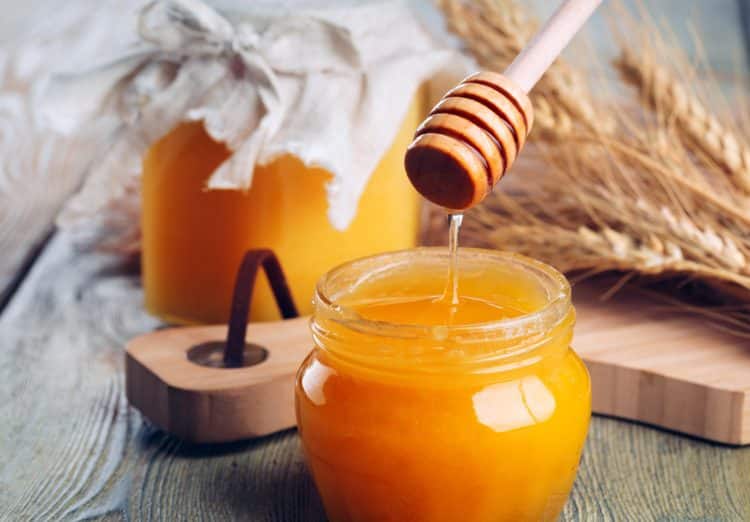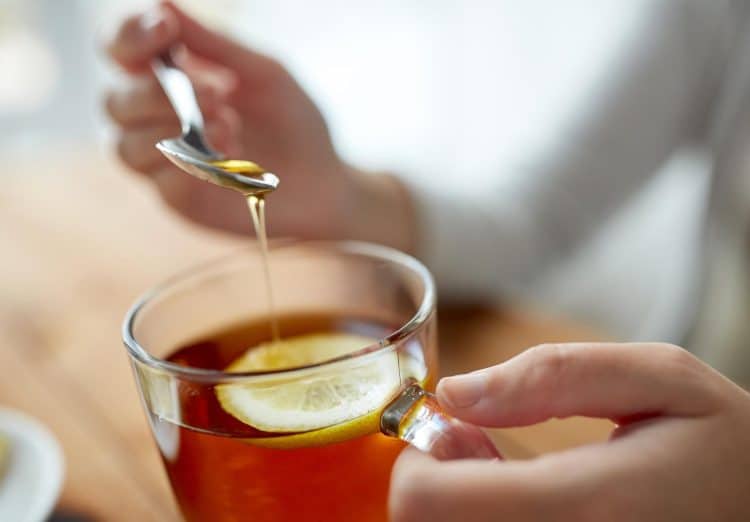Wherever there are plants, trees, flowers, and bees, there is always honey. Except for Antarctica, every country has its native bee species whipping honey in their hives. Honey is found worldwide and boasts several benefits. This article delves deep into the realm of honey and its implications on your fasting routine.
[sc name=”style-summary2″ ]
Does Honey Break Your Fast?
Honey is a natural sweetener frequently added to teas, coffees, and baked items. While some individuals incorporate honey into their lemon tea during fasting periods, it’s essential to understand its impact on fasting. Honey mainly consists of simple sugars that can cause an insulin spike. Consequently, consuming honey will indeed break a fast. Read further to understand why.
[/sc]
What is Honey?
Most people know honey as their trusty topping for pancakes or muffins or their go-to sweetener for tea or coffee. This widely used additive is also a common ingredient in baked goods, snack bars, salads, and breakfast bowls with yogurt or oatmeal. Its use in our daily routines extends beyond the kitchen. Honey has also gained popularity for its widespread use in skincare routines.
From a more scientific or scholarly perspective, “Honey is a supersaturated solution of sugars mainly comprised of D-fructose, D-glucose, sucrose, maltose, and higher sugars.” [1]
It is a thick, sticky, viscous liquid with a golden hue.

How is Honey Made?
The story of the queen bee and her worker bees is common knowledge.
Bees have sensory organs that are sharper than those of humans. Older female worker bees do the foraging. They normally scout their surroundings for the best plants to take nectar from and pass the message on to other bees through a ‘waggle dance.’ [2]
Once they choose their flowers, they collect the nectar or honeydew from the plants. This is stored in a part of their gut called the honey crop, where the complex sugars in the nectar are broken down into simpler sugars by salivary enzymes. Once their honey stomach is filled, they return to the hive and pass the nectar to the younger worker bees. These hive bees spend hours processing the nectar, passing it on to the next bee, and placing it methodically in the honeycomb cells. Later, the hive bees rapidly fan their wings to kick-start the evaporation process until the water content drops to as low as 18%. A thick liquid, highly concentrated in sugar — honey — is formed.
Bees then ensure there’s very little moisture to prevent the honey from fermenting. This keeps honey fresh for a long time. When the honey is just right, they seal up the honeycomb with wax.
Honey’s flavor and other characteristics will differ based on the flowers it comes from. [3]

Why Do Bees Collect Nectar?
Bees go on two to five-kilometer trips from their hives to find nectar. On each trip, they collect nectar from over 50 flowers and do this around 20 times. But it can change based on how much nectar the bee can hold, how much nectar the flower has, and how far the hive is from the flower. The title “busy bee” is certainly well-deserved. But why are they even busy?
In a bee’s entire lifetime, it collects less than half a teaspoon of honey, which is its food. Flowers don’t bloom continuously, and bees don’t gather nectar when it’s chilly or rainy. They make honey in the spring and summer to save it for times when they can’t find flowers or nectar. [3]
Honey Nutritional Information
According to FitnessVolt Food Facts, one tablespoon (21g) of honey contains 63.8 calories, 17.3 grams of carbs, and no protein, fat, or cholesterol.
The relatively high-calorie count is because honey packs a good amount of sugar, particularly glucose, and fructose. A tablespoon of honey contains roughly 17g of total sugar.

[sc name=”style-summary2″ ]
You can find the nutritional profile of any food or combination of foods through the FitnessVolt Food Facts and generate a nutrition label for your reference.
[/sc]
Fasting
Fasting means voluntarily abstaining from food for a few hours or even days. It’s a well-known diet practice that’s been used in medical treatments for a long time. Hippocrates, the father of modern medicine who lived more than 2,000 years ago, used to suggest fasting for patients with certain symptoms. He once said, “To eat when you are sick is to feed your sickness.” Fasting has been a part of many cultures and religions around the world.
There are several fasting techniques. Some popular types of fasting, as noted by Jason Fung, are discussed below: [4]
Intermittent Fasting
This fasting approach revolves around alternating between fasting and eating windows. The 16/8 fasting, One Meal a Day (OMAD) fasting, and 5:2 fasting fall under the intermittent fasting umbrella. Popularly endorsed by celebrities, IF soared to the top as Google’s most searched diet method in 2019. While in a fasting phase, you’re free to enjoy non-caloric beverages such as coffee, green tea, and lemon juice. In specific forms of intermittent fasting, such as the 5:2 diet or alternate-day fasting, a modest intake of about 500-600 calories is allowed throughout the day.
Water Fasting
As the name suggests, the water fasting protocol does not allow the consumption of anything besides water during the fasting window. However, you can include electrolytes and salt in your water if fasting for prolonged periods.
Juice Fasting
You are allowed to have juice during your fasting period. This does not include canned beverages or fruit juices, as they would destroy the point of a fast. Your fasting menu will include only low-sugar green smoothies.
Other variants of fasting differ based on when to eat, what to eat, and how long the fast lasts. Studies have suggested that fasting may offer potential benefits like reduced fat, reduced risk of diabetes, and other aging-related issues. It can also improve cognitive function. [5][6]
Can You Have Honey During Fasting?
Simply put, no. Read further to understand why.
Reasons You Shouldn’t Have Honey During Fasting
Here are some reasons to avoid honey while fasting:
Against the Rules
In most fasting methods, you cannot consume any calories. Even your tea or coffee should be free from sweet stuff or milk. Bringing honey into the mix breaks the fasting rules.
Interferes With Ketosis
Our body needs two fuels for energy– glucose (from carbs and sugary foods) and fat. Glucose comes from the food we consume. The glucose is converted into energy to aid our metabolic activities. The leftover energy is stored as glycogen or fat. The body burns fat for energy when it runs out of glucose.
Within 24 hours of fasting, the body turns to the glycogen reserves in the liver for energy. However, it is not infinite and runs out within another 24-36 hours.
After over 48 hours of fasting, the body starts breaking down fat for energy. This happens through a process called ketosis. To enter this stage, the body should not have any glucose or glycogen reserves.
Honey has approximately 64 kcal of energy. Consuming honey will provide the body with glucose and hinder ketosis. No Ketosis, no fat loss.

Causes Blood Sugar Spike
One tablespoon of honey has more carbohydrates than one tablespoon of sugar. It also tastes sweeter than sugar. Although honey has slightly lower glycemic index levels when compared to sugar, its value is still high. It can cause a significant spike in insulin and blood sugar levels. Our insulin sensitivity increases typically while fasting. Honey intake can cause a more pronounced insulin reaction, which triggers a sugar crash. Eating honey will end up making you feel more tired.
Reduces the Benefits of Fasting
Weight loss, insulin sensitivity, autophagy, better heart health, and detoxification are some benefits of fasting. Most of these benefits come from giving our body a break and letting it heal. Eating honey prevents you from achieving these benefits.
Resisting Temptation Becomes Harder
The sugar crash from your impromptu honey meal sends signals to your brain that it needs more energy. This kickstarts your hunger pangs. Your sugar cravings may also intensify. It takes a lot of discipline and self-control to keep your mind away from food. A sudden indulgence, however small, can undo all your progress. Once you’ve tasted honey, you will find excuses for eating more or other sweet things.
Exception
Though strict fasting typically excludes honey, whether you include it or not depends on your chosen fasting style. Nowadays, fasting methods are all about tailoring them to your lifestyle, health goals, and what motivates you. Some fasting types, like the 5:2 fast or Alternate Day Fasting, allow eating 500–600 calories on fasting days. This is sometimes dubbed “dirty fasting.” [7]
Since honey fits that calorie range, having a spoonful or even less is okay. Many people say that this approach makes sticking to the fasting plan easier. But, there is no empirical evidence to show that dirty fasting gives you the same benefits as strict fasting.
What Should You Do Then?
Honey boasts a bounty of antioxidants and is definitely a better choice than regular sugar. It’s believed to improve heart health and is a go-to remedy for coughs in many households. Honey has been used for external healing throughout history thanks to its antibacterial qualities. Even though you should steer clear of honey during your fasting window, alternative routes exist to tap into its advantages.
Use it to Break a Fast
Add a dash of honey to warm lemon juice and drink it to end your fast. Fasting usually causes digestive issues like nausea or acid reflux as a side effect. Taking honey stabilizes your digestive tract and gives you an energy boost. This is a good substitute for a large meal after fasting. It also provides weight-loss benefits and can help you achieve your fasting goals faster.
Make a Face Mask
Keep your daily honey intake within the two-tablespoon mark. But if you grab the honey jar often while fasting or anytime, think about using it on your face. Its antibacterial qualities can work wonders for acne and other skin troubles. Plus, you’ll get to enjoy a relaxing mini-spa session and walk away with a fresher, brighter skin. [8]

Use it as a Sweetener Instead of Sugar
Raw honey has a glycemic index (GI) range of 50 to 60, while white sugar falls within 60 to 65 on the GI scale. Various honey types might showcase even lower or higher GI values. The modestly lower GI value of honey indicates a slower absorption by the body. Consequently, honey has a slightly gentler impact on blood sugar levels than white sugar. Honey also offers a broader spectrum of nutritional benefits.
This does not mean that it is suitable for people with diabetes. According to the Mayo Clinic, replacing sugar with honey makes no difference for people with diabetes. They should avoid it as much as they avoid sugar.
Some Natural Substitutes For Honey
Try these alternatives to honey while fasting.:
Monk Fruit Extract
The juice from this fruit, also known as the Buddha fruit, is dried and turned into a powder extract. Even though the fruit has natural sugars like fructose, they don’t show up in its juice. However, despite the lack of sugars, this extract is still 100 times sweeter than sugar, all thanks to unique compounds called mogrosides. That’s what makes monk fruit extract a zero-calorie sweetener.
You only need a tiny bit of this extract to add sweetness to your coffee or tea.
Stevia
Here’s another popular natural honey alternative. This sweetener comes from the leaves of the stevia plant. You can add it to your tea or the list of fasting-approved drinks. However, some people don’t like its bitter aftertaste. You should experiment with different stevia products to find the one you enjoy. Find the Best stevia products here.
Related: Which Sweeteners Can Break Your Fast? Find Out Here.
Sugar Alcohols
Sugar alcohols like erythritol and xylitol are incredibly low in calories and don’t trigger significant spikes in blood sugar levels. These sweeteners are commonly found in sugar-free gums, toothpaste, mints, and similar products. They don’t break your fast because of their low-calorie content. But they may affect your gut health.
Allulose
This type of sugar is a rarity, found in a handful of foods like wheat, raisins, figs, and molasses. It is unique because our bodies can’t absorb this sugar, and it doesn’t cause rapid increases in blood sugar levels. Although it is almost as sweet as sugar, it contains very few calories.
Tagatose
This natural sweetener has a very low glycemic index and calorie count. It helps regulate blood sugar levels, making it great for people with diabetes. You can find small amounts of it in dairy products.
You must gradually reduce your reliance on honey and other sugary items. Challenge yourself to enjoy your coffee or tea without it. Opt for other fasting-friendly beverages like water, lemon juice, or broth. While this might not be a honey enthusiast’s favorite advice, it will help you on your fasting journey.
Find Out: Does Lemon Water Break Your Fast?
FAQs
Is crystallized honey bad?
Crystallized honey is safe to consume. It will melt when you heat it in a bowl of warm water.
Which honey is better?
The clearer the honey looks, the more processed it is. However, some types of honey are darker than others. This is because it was made out of the nectar of different flowers. Choose raw or darker-colored honey, as they have more nutritional benefits than lighter honey.
How much honey can I eat in a day?
On a typical day, even when you are not fasting, you shouldn’t consume more than 100 calories of added sugar. According to the American Heart Association, women can consume around 24g (six teaspoons) of honey daily, and men can have 36g (nine teaspoons).
How much honey can I have while fasting?
You cannot have honey while fasting. If your fasts are flexible, you can consume the daily recommended amount of 24g of honey for women and 36g for men during the feeding window.
How much honey can I have on a keto diet?
Since honey is high in carbohydrates, you should not have it while on a keto diet.
Can I have honey during pregnancy?
Yes, you can have honey during pregnancy.
Bottom Line
Honey has its benefits, but you must avoid it during fasting. It’s easy to find little loopholes, like thinking a bit of extra exercise will burn the honey or that adding just a touch of it isn’t a big deal. However, these habits can undermine the benefits of fasting.
To fully reap the benefits of fasting, avoid calories during the fasting window and save honey for your eating window.
References
- Pavlova et. al. (2019). Quality characteristics of Honey: a review. in Proceedings of University of Ruse (Vol. 57).
- Ministry of Agriculture, Food and Fisheries. (n.d.). Apiculture Factsheet. In gov.bc.ca.
- Bradbear & FAO-Food and Agriculture Organization. (2009). Bees and their role in forest livelihoods. In Definition and Uses of Honey (pp. 81–88).
- Fung, J. & Moore, J. (2016, October 18). The Complete Guide to Fasting: Heal Your Body Through Intermittent, Alternate-Day, and Extended Fasting.
- Shin, B. K., Kang, S., Kim, D. S., & Park, S. (2018, January 7). Intermittent fasting protects against the deterioration of cognitive function, energy metabolism, and dyslipidemia in Alzheimer’s disease-induced estrogen-deficient rats. Experimental Biology and Medicine, 243(4), 334–343.
- Dong, T. A., Sandesara, P. B., Dhindsa, D. S., Mehta, A., Arneson, L. C., Dollar, A. L., Taub, P. R., & Sperling, L. S. (2020, August). Intermittent Fasting: A Heart Healthy Dietary Pattern? The American Journal of Medicine, 133(8), 901–907.
- Kubala. (2021, June 22). Dirty Fasting: Effectiveness, Recommendation, and More. Healthline.
- Watson, K. (2019, January 4). Honey for Face: Uses and Benefits. Healthline.


